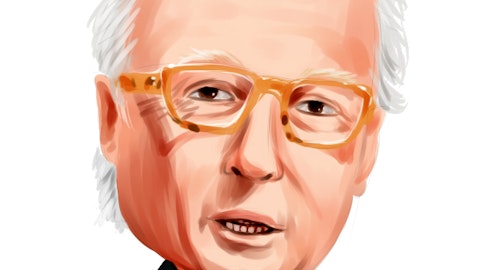National Bank Holdings Corporation (NYSE:NBHC) Q2 2023 Earnings Call Transcript July 20, 2023
Operator: Good morning, everyone, and welcome to the National Bank Holdings Corporation 2023 Second Quarter Earnings Call. My name is Anna, and I will be your conference operator for today. [Operator Instructions]. As a reminder, this conference is being recorded for replay purposes. I would like to remind you that this conference call will contain forward-looking statements including, but not limited to, statements regarding the company’s strategy, loans, deposits, capital, net interest income, noninterest income, margins, allowance, taxes and noninterest expense. Actual results could differ materially from those discussed today. These forward-looking statements are subject to risks, uncertainties and other factors which are disclosed in more detail in the company’s most recent filings with the U.S. Securities and Exchange Commission.
These statements speak only as of the date of this call, and National Bank Holdings Corporation undertakes no obligation to update or revise these statements. In addition, the call today will reference certain non-GAAP measures which National Bank Holdings Corporation believes provides useful information for investors. Reconciliations of these non-GAAP financial measures to the GAAP measures are provided in the news release posted on the Investor Relations section of www.nationalbankholdings.com. It is now my pleasure to turn the call over and introduce National Bank Holdings Corporation’s Chairman, President and CEO, Mr. Tim Laney. Please go ahead, sir.
Tim Laney: Thank you, Anna. Good morning, and welcome to National Bank Holdings’ Second Quarter 2023 Earnings Call. I’m joined by Aldis Birkans, our Chief Financial Officer. We delivered solid earnings for the quarter, representing a year-to-date increase of $34.1 million or 88% over prior year same period earnings. Our core earnings engine remains strong and adjusting for the impact of investment valuations met our expectations. Our credit quality is excellent, and our core deposits grew 29% annualized during the second quarter, with a common equity Tier 1 ratio of 11.08% an ample liquidity, we continue to serve as a source of strength in our markets. And on that note, I’ll turn the call over to Aldis. Aldis?

Photo by Julian on Unsplash
Aldis Birkans: All right. Well, thank you, Tim, and good morning. Thank you for joining our earnings call this quarter. For the second quarter 2023, we reported net earnings of $32.6 million or $0.85 per diluted share. The closing and integration of the Cambr acquisition has gone extremely well, and it has — it already is contributing nicely to our financial results. The core deposits growing $539 million this quarter or 29% annualized. On a year-over-year basis, we have grown our quarterly pre-provision net revenue by $14.5 million or 49%, driven by strong organic balance sheet growth, well executed acquisitions, and as always, strong discipline on expenses. We continue to be pleased with the organic loan growth our teams have generated.
During the second quarter, our loan balances grew 3.8% annualized. And on a year-to-date basis, our loan growth has been 5.4% annualized. Entering the second half of 2023, our loan pipelines are strong, which should allow us to achieve our full year loan growth guidance of mid- to high single digits. As I previously mentioned, our core deposit balances grew $539 million during the quarter, which allowed us to pay down the more expensive FHLB debt and bring our loan-to-deposit ratio down to 91%. During our first — first quarter’s earnings call, we mentioned that market conditions were demanding more aggressive deposit pricing, and that is reflected in this quarter’s cost of deposits. Nevertheless, our total deposit beta to date through this cycle remains quite low at 22%.
Fully taxable equivalent net interest income for the quarter came in at $91.2 million, down $5.1 million from the prior quarter, driven by higher cost of deposits. The second quarter’s new loan originations of $362 million came in at an average weighted yield of 8.2%, which resulted in our loan book yield increasing 24 basis points to 6.15%. The resulting net interest margin was 4.07%, and we project NIM to dip slightly below 4% for the second half of 2023. In terms of our asset quality, it remains strong with just 2 basis points of annualized net charge-offs and 1.25% allowance to total loans. This quarter’s provision expense covered new loan growth, nominal charge-offs and supported the slight increase in the reserve requirements based on the CECL model macroeconomic outlook changes.
Total noninterest income for the second quarter was $13.8 million. Included in this quarter’s results was $4.1 million in impairments related to our venture capital investments. This was a result of our quarterly equity investment assessment process, where we review the financial performance and market dynamics underlying our investments. Excluding this impact, our core banking fees grew $3.3 million versus the prior quarter with an impressive 89% annualized. Service and bank card income increased $797,000 on a linked quarter basis and $1 million over the same quarter last year. Other banking income increased $2.5 million on a linked quarter basis, mainly driven by Cambr fees and pickup in our mortgage banking income. Looking ahead for the second half of 2023, we project noninterest income to be in the range of $34 million to $36 million.
Noninterest expense for the second quarter totaled $61 million, which was effectively flat with the prior quarter excluding the first quarter’s onetime $2.5 million payroll tax credit benefits. Expenses continue to be well controlled, and for the second half of 2023, we are projecting noninterest expense to be in the range of $123 million to $125 million. Finally, our capital ratios remained strong at 11.08% common equity Tier 1 ratio and 9.15% Tier 1 leverage ratio. And we maintained sufficient excess capital to provide for various strategic options. Tim, with that, I’ll turn it back to you.
Tim Laney: Thank you, Aldis. We remain focused on earning the full relationship of our clients. A focus on deposit growth and treasury management is not new to us. It’s in fact, a core strength. We operate with zero broker deposits and a high level of noninterest-bearing deposits. With regard to credit, we have a comparatively low CRE exposure, and we continue to build and manage a diversified and granular loan portfolio. Finally, we operate in attractive markets that we believe will support tremendous growth opportunities for NBH. And on that note, Anna, we are ready to open up the line for questions.
See also 20 Countries With Highest Rate Of Down Syndrome and 25 Poorest States in America.
Q&A Session
Follow National Bank Holdings Corp (NYSE:NBHC)
Follow National Bank Holdings Corp (NYSE:NBHC)
Operator: [Operator Instructions]. And we’ll now take our first question from Jeff Rulis with D.A. Davidson.
Brett Thompson: This is Brett Thompson on for Jeff. I was wondering if you could provide a bit more color…
Tim Laney: Good morning.
Brett Thompson: I was wondering if you could provide a bit more color on the $24 million increase in NPAs this quarter. Kind of what loan segment or segments is that increase coming from? Is it from several borrowers or kind of fewer large relationships? And kind of the type of relationships, legacy or acquired that those were — and then lastly, if you could provide thoughts on similar loans on nonaccrual that may be impacted?
Tim Laney: Yes, sure. Very good question. Look, the nonaccrual increase was driven really by 1 asset-based lending-based relationship. And we believe we’ve already adequately reserved for any potential loss exposure there. So look, it’s been well managed. It was asset-based. We feel comfortable with our advance rates. But as we’ve historically done, we’re going to be aggressive on dealing with any emerging problems.
Aldis Birkans: Yes. And Brett, I would add that when we look at on total criticized loans, bulk actually came down this quarter. So this loan had been accounted in that rate for a period of time already.
Tim Laney: So again, already adequately reserved for — and I expect it to be resolved, if not third quarter, by the end of the year.
Brett Thompson: Great. And then if I could just ask one more. You guys touched on it a bit more in the remarks, but just to revisit it. The increase in deposits, were those largely from the Cambr acquisition? And if so, should we assume that those deposit transfers are largely done? And then lastly, just as an outlook for deposit growth going forward. You have a goal to get to 90% loan-to-deposit ratio, which was achieved. Is that going to drift back up again?
Aldis Birkans: Well, certainly, the last part of that question will depend on the loan growth and deposit growth, and behavior — certainly, deposit — deposits have been intense over the last several months. But to answer the first part of the question, yes, a good chunk is Cambr-related. We will not provide more detailed guidance just to give ourselves flexibility in how we manage the balance sheet. For that matter, the sort of the Cambr fees, we will not provide more guidance on a forward basis, either just to give ourselves ability to manage the balance sheet and flow that program without jeopardizing our competitive advantage.
Tim Laney: Yes. And I would add, one, we’re not going to provide specific guidance. Obviously, we’ve got the flexibility to hold larger levels of non-brokered deposits from Cambr, we choose to do so. But we like the business model. We like supporting other financial institutions, the spreads that come along with that. And so we’ve got flexibility there, but we certainly intend to strike a balance.
Operator: We’ll now take our next question from Kelly Motta with KBW.
Aldis Birkans: Kelly, your voice has changed.
Unidentified Analyst: Sorry. This is Matt on for Kelly. I wonder if we could just hit on noninterest-bearing deposits for a second. Want to see if you guys are following trends, with — if — the pace of those running off is slowing down or what we think they might stabilize that? Or any kind of color you can give us on those noninterest-bearing deposits.
Aldis Birkans: Yes. What we really — timing-wise, what we saw, the biggest remix shift took place in late March, early April, or call it, month or early part of the second quarter. That has stabilized then. As we sit today, for example, our noninterest-bearing deposits are flat through month of July. So we feel like at least the trends have normalized.
Unidentified Analyst: All right. Great. And then if you guys could give any more color just on margin. If you’ve seen the pace of margin decreasing, slowing down at all? Or any kind of guidance you can give us on that.



